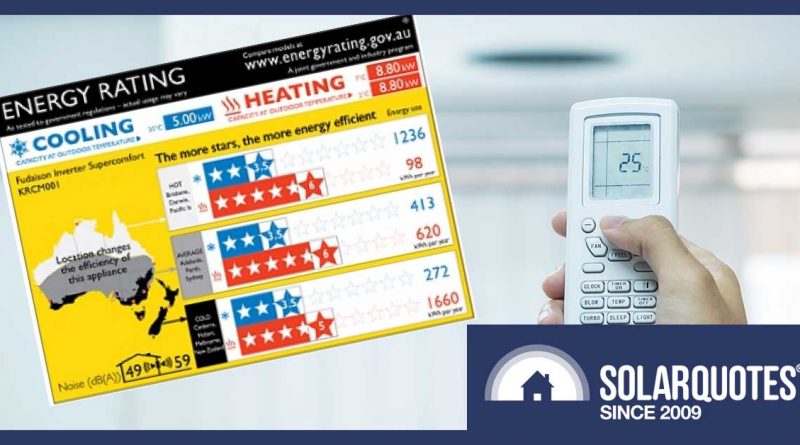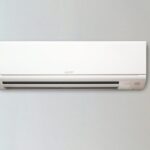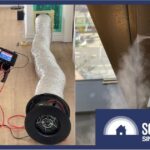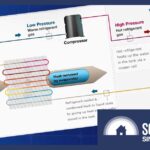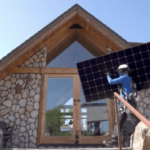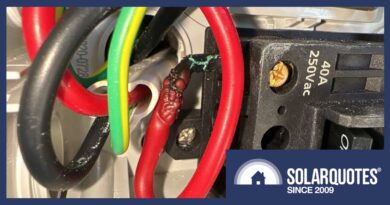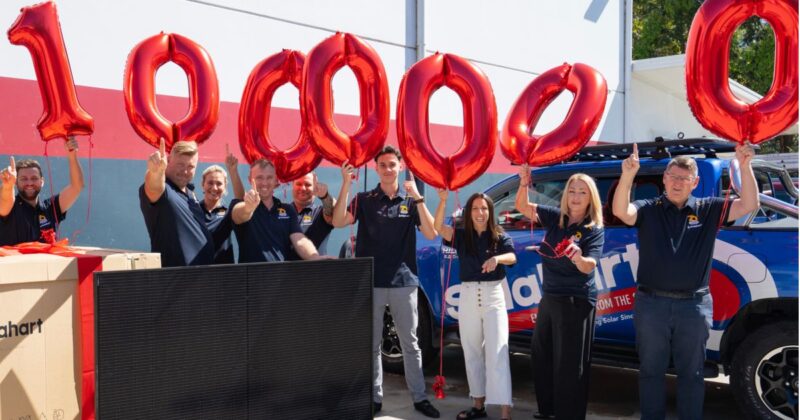New Energy Rating Labels For Air Conditioners Are Brilliant
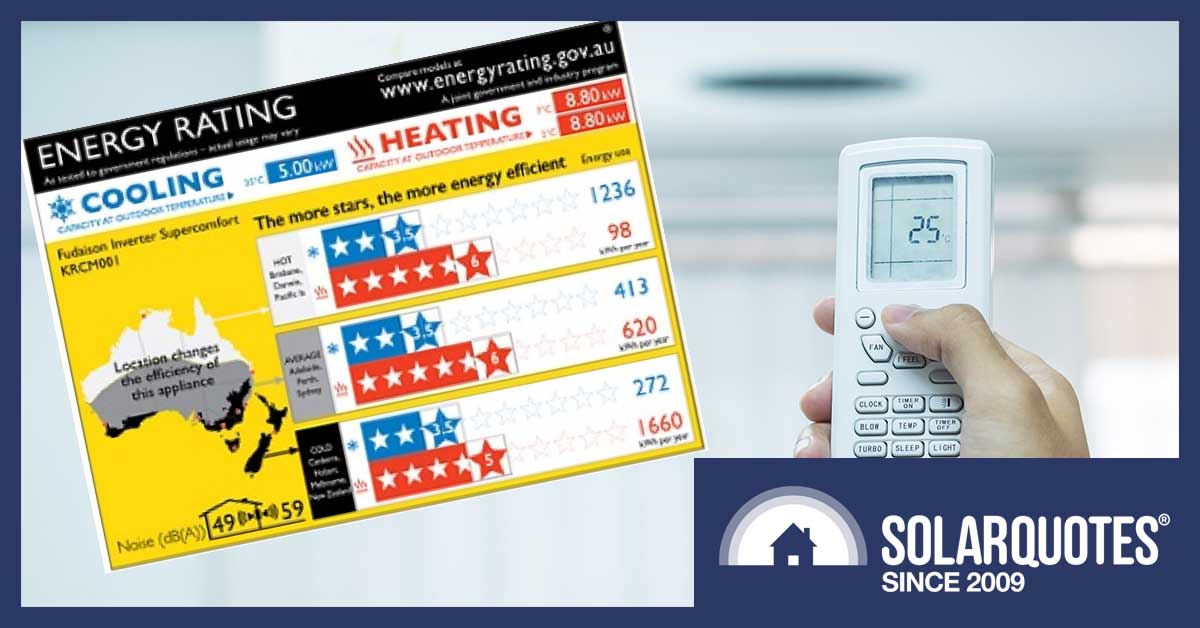
New aircon energy rating labels! Are you excited? You should be…
The most energy-efficient and cost-effective way to heat your home is to use your reverse-cycle air conditioner. Even the least efficient aircon uses far less energy than electric resistance heating. But buying the least efficient air conditioner is a bad idea. You’ll be better off with a highly efficient one — or at least the most efficient one that doesn’t cost an arm and a leg.
To help those looking for an air conditioner that won’t guzzle electricity, the government has introduced improved energy efficiency labels. Because an air-conditioner’s efficiency depends on the local climate, they divide Australia into three zones — Hot, Average, and Cold — with New Zealand included in the cold zone.
You can see the new labels on some air conditioners in stores now, but the old ones may not all be gone until March 2025.
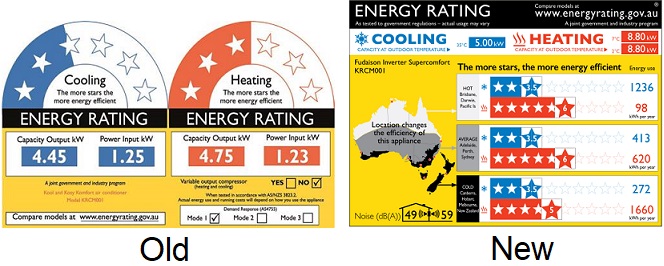

The new labels will eventually be required for all residential-sized split system air conditioners. These have an indoor wall unit and an outdoor compressor unit. Window mounted units will also need them. Large ducted air conditioners aren’t required to have the new labels, but manufacturers are permitted to obtain and display them.
The majority of air conditioners are reverse cycle and will have stars for both cooling and heating, but some units can only cool and will have no energy stars for heating.
What This Article Covers
In this article, I’ll tell you:
- Why air conditioners are efficient at heating and cooling.
- How your local climate affects their performance.
- How to use the new labels to choose a cheap-to-run air conditioner.
But if you want to get it straight from the horse’s mouth, the Department of Energy and the Environment has a 14 page brochure. If you just want a quick explanation of the new labels, there is also a two page guide. More online information can be found here.
Moving Heat Is Better Than Creating It
Air conditioners are heat pumps. Now I’ve told you this, it shouldn’t come as a surprise to learn they work by pumping heat around. In summer they pump heat out of homes and in winter they pump it in. One kilowatt-hour of electricity spent pumping heat into your home can provide several times as much heat energy as using one kilowatt-hour of electricity to generate heat with electric resistance heating.
Electric resistance heaters come in several types:
- Little space heaters with a heating element and fan inside which blows hot air.
- Oil-filled radiators.
- Bar heaters with a visible element that glows orange. (If it ever glows white — run.)
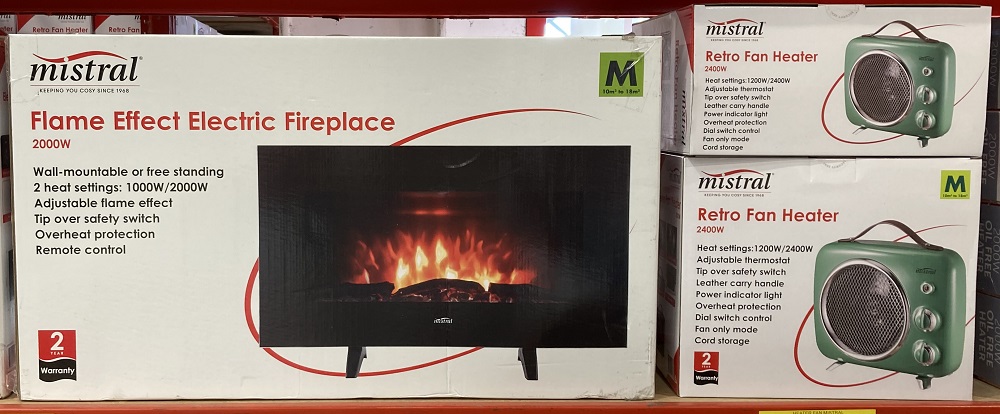
Electric resistance heaters also come in flat versions I try to watch TV on when I’m drunk1 and Hipster bait.
Electric resistance heaters are 100% efficient at turning electrical energy into heat. Making heat is actually the only thing we can do with 100% efficiency. Because nothing can be more than 100% efficient without being a perpetual motion machine, you may be wondering how a heat pump can be even more efficient.
[embedded content]
Well, technically they’re not. They’re less than 100% efficient at moving heat around, but you end up with a lot more heat by using energy to move it around rather than using the same energy to create the heat directly. An electrical resistance heater can turn one kilowatt-hour of electrical energy into one kilowatt-hour of heat, but a heat pump can use one kilowatt-hour of electricity to move three or more kilowatt-hours of heat into your home.
The same thing happens when an air conditioner is used for cooling. It just goes the other way and moves the heat out of the house.
Improving Air Conditioner Efficiency
The average efficiency of air conditioners has been improving thanks to energy efficiency standards introduced here and overseas. The free market wasn’t able to rapidly boost efficiency levels by itself because people have a bad habit of not considering operating costs when buying things. Left to itself, the market also doesn’t take into account the benefit of reducing strain on the grid by lowering peak electricity demand on very hot or very cold days, or the benefit to the environment of reducing fossil fuel consumption.
The graph below shows how many kilowatt-hours of heat air conditioners tested from 2000 to 2014 will move out of your home per kilowatt-hour of electricity consumed:
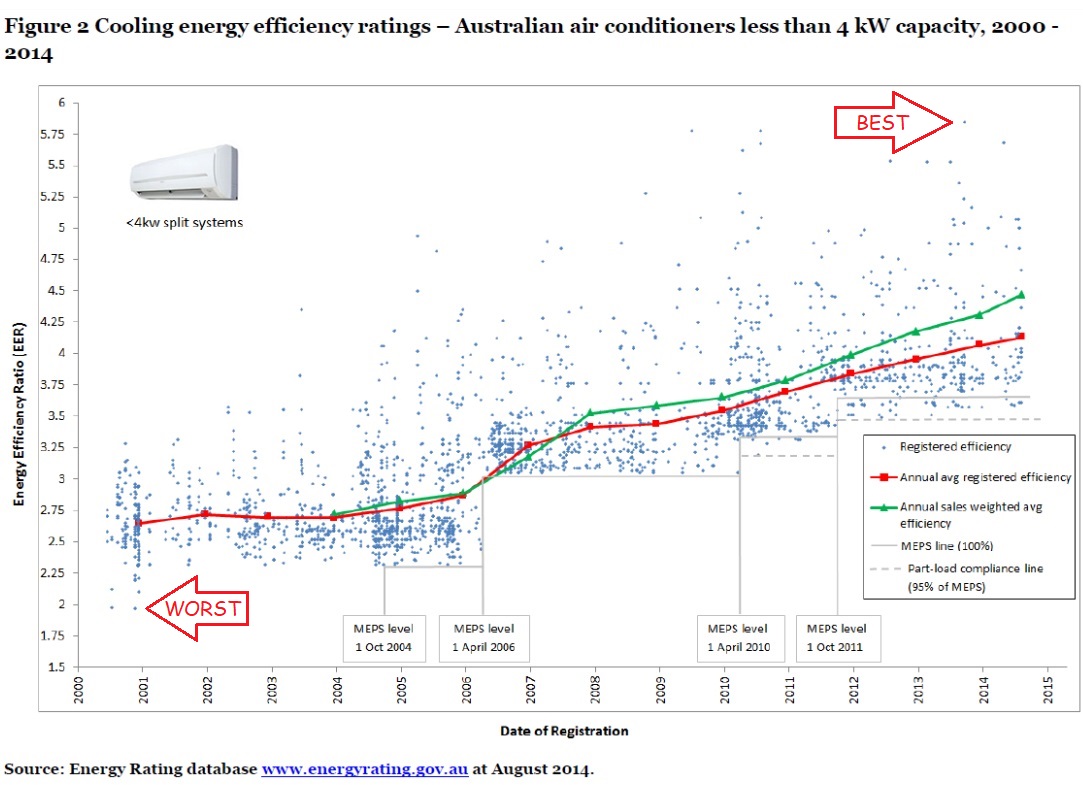

While the graph is badly out of date, it does show efficiency has been improving. You can also see even the worst air conditioner, tested back in 2000, moves twice as much heat energy as it consumes in electrical energy. The most efficient air conditioner on the graph was tested in 2013 and could shift 5.8 kilowatt-hours of heat for every kilowatt-hour of electricity consumed.
The majority of home air conditioners for sale are reverse-cycle, which means they can both heat and cool. I can’t recommend getting an air conditioner that isn’t reverse cycle unless you live in Darwin where the lowest temperature reached last year was 16 degrees. Of course, if you’re in Darwin and felt like you were freezing to death when the temperature plummeted to 16 degrees and the gallium in your thermometer froze solid, then you should get a reverse cycle air conditioner.
Aircon Efficiency & Air Temperature
An air conditioner used for heating can still move heat into your home even if the air temperature is below zero. This is because air at zero °C still has 93% of the heat energy it has at 20 °C. It won’t have zero heat until it hits -273.15 °C.
But air conditioners aren’t going to work when it’s a couple of hundred degrees below zero. Their effectiveness drops as the air temperature gets lower. Ones designed for cold weather conditions can be more efficient than electrical resistance heating down to -30 °C. In Australia, the air doesn’t get that cold. Australia’s record low temperature was -23 °C in the Snowy Mountains and the lowest in any capital was -10 °C in Canberra.
This means air conditioners, which are air sourced heat pumps, remain an energy-efficient method of heating in the coldest Australian weather. In countries where it does get too cold for air source heat pumps to work, they get around the problem by burying the air conditioner coils underground. This is rarely done in Australia because it adds thousands to the cost of installation for only a modest increase in efficiency.
How Air Conditioners Work
Air conditioners have a fluid2 inside called “refrigerant” or just “working fluid”. Thirty-five years ago, if this air conditioner juice was let loose it would chew a hole in the ozone layer. But the world came together and agreed to phase them out for the good of the planet. (See? It can be done.) While the working fluid these days is less environmentally destructive, it can still be flammable, so remember to never smoke while stabbing your air conditioner.
When heating your home, the working fluid in the outside part of a split system air conditioner starts off as a liquid and boils or evaporates into a gas. When a liquid changes from a liquid to a gas it absorbs a lot of heat and this comes from the outside air, even if it’s cold by Australian standards. Before entering the indoors section, the gas is compressed into a liquid. The heat energy in the gas is concentrated into a small area and — because the amount of heat energy stays the same while its volume decreases — its temperature goes up. Because it’s hot, the heat energy can be blown into your home and then the cycle repeats.
Factors Affecting Efficiency
A number of factors affect how efficiently air conditioners operate. Some are more efficient at peak output while others do better when running at low power. How well they remove humidity from the air also affects efficiency as people feel cooler in dry air. But in cold climates, the most important factor is usually how efficiently the air conditioner deals with defrost cycles.
When the air temperature falls below 5.5 °C ice will start to form on an air conditioner’s outside coils. Defrosting them requires energy and some units handle this more efficiently than others. In hot climates, air conditioners will rarely have to run a defrost cycle, but in places such as Melbourne and Canberra, it’s very common and can have a large effect on efficiency.
Old Energy Efficiency Label (ERL)
The old Energy Rating Label (ERL) looked like this:
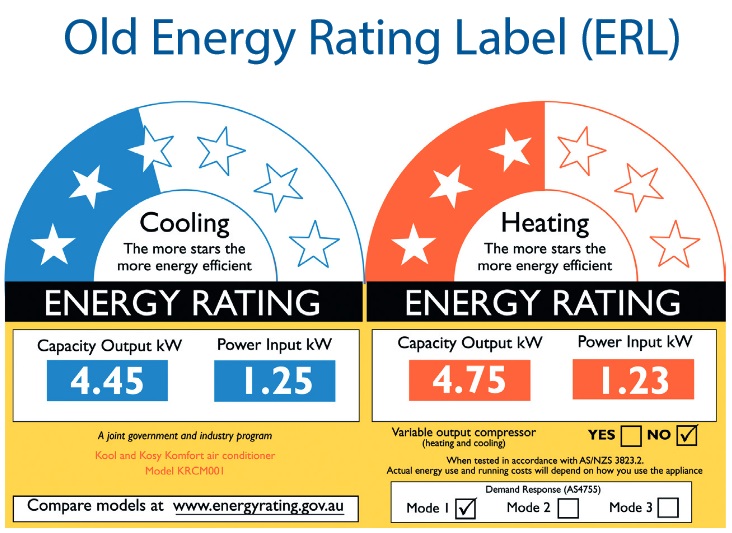

While not as good as the new ones it still gives useful information. They show how much electrical power is drawn under “Power Input kW” at high output and how much heating or cooling it provides under “Capacity Output kW”. If I was considering buying this air conditioner I would divide the Capacity Output by the Power Input to work out its efficiency. This would give:
- Cooling: 1 kilowatt-hour of electricity will move 3.56 kilowatt-hours of heat out of a home.
- Heating: 1 kilowatt-hour of electricity will move 3.86 kilowatt-hours of heat into a home.
But most people aren’t going to do this. They are just going to look at how many stars it has. The problem with this is, air conditioner efficiency can vary considerably depending on the local climate, and the old labels don’t don’t take this into account. The new ones were designed specifically to deal with this issue.
Zoned Energy Efficiency Label
Here’s what the new Zoned Energy Rating Label or ZERL looks like. This is an actual photo I took in a store, which is just one example of how I provide you with hard-hitting realism:
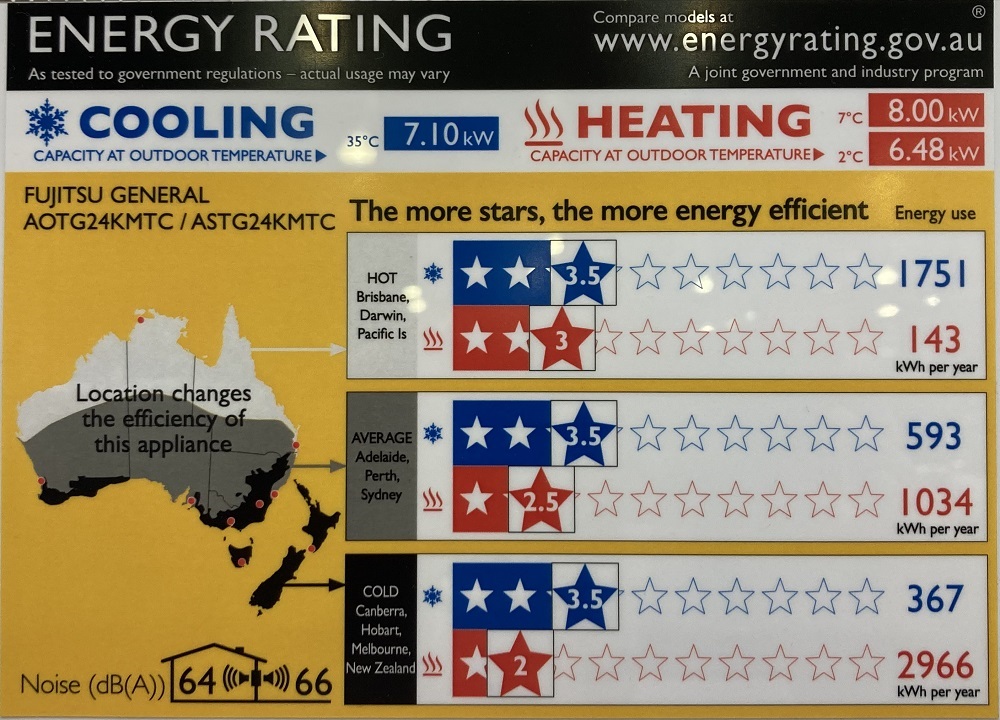

As you can see, the new label is a lot busier than the old one. This is mostly due to the addition of climate zones, although there are other improvements. While it looks a lot more complex, it’s not too bad as you only need to worry about information for the climate zone you are in.
Label Header
The label starts off simply by telling you what it is and giving a link where you can get more information:


I think the website it points you to could be better. It needs a tool allowing you to enter your location, the air conditioner you’re considering and its price, and spits out the total cost of ownership over 10 years.
But whenever I suggest something along those lines I get worried some executive will see it and spend hundreds of thousands of dollars to get that function when it should cost peanuts. Maybe several tonnes of peanuts, but that’s still not hundreds of thousands of dollars. (Peanuts are about $2,000 a tonne — as anyone from Kingaroy could tell you.)
Cooling And Heating Capacity
Below the heading is the cooling and heating capacity:


This is not efficiency information. It’s to let you see if its output is enough to either cool or heat the area you’re installing it in. There are sites which can help determine what size are conditioner you need, such as this page by CHOICE, and checking them out can give an idea of how much capacity you’ll need.
Getting one approximately the right size for the interior space and local climate is important. This is because if it’s…
- Too small — It will run flat out a lot of the time, which can be energy inefficient and it may not be able to raise the temperature as high, or decrease it as low, as you’d like.
- Just right — It should run efficiently and you won’t have wasted money by buying an air conditioner larger than you need.
- Too large — You’ve probably wasted money by getting a unit larger than you require. If it’s a little too large this shouldn’t affect efficiency, but if it’s much too large it may heat or cool in short bursts and rarely operate at its most efficient level.
The new label has one figure for cooling when the outside air temperature is 35 degrees. But there are two figures for heating — one for an outside temperature of 7 degrees and one for 2 degrees. The main reason there are two figures is because below 5.5 degrees ice starts forming on an air conditioner’s outside coils and the required defrosting cycles can cause a considerable reduction in heating capacity. An air conditioner that does poorly at 2 degrees compared to 7 degrees may be fine in Brisbane where it rarely gets very cold, but a poor choice for in a place like Hobart.
Climate Zone Map
On the left side of the label, there is a map of Australia divided into three climate zones. Here’s a version that’s a little clearer than the one in my photo:
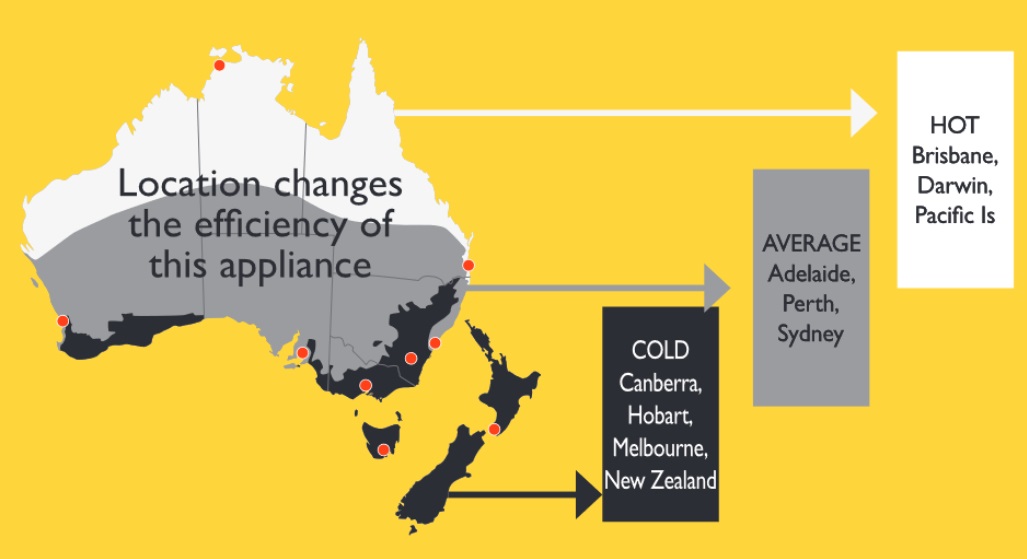

As you can see, at some point New Zealand snuggled up a lot closer to Australia than it used to be. But that’s understandable. Who wouldn’t be attracted to us?
While New Zealand’s South Island is a degree or two colder than their North Island, they’ve clearly decided it’s not worth the effort of dividing their country into the separate zones of “Cold” and “Cold enough to freeze the crown jewels off a brass coat of arms.”

The NZ Coat of Arms commemorates the time the people of New Zealand came together as one to find out who stole their ugg boots.
Each zone is based on a climate in a reference location:
- Hot: Rockhampton
- Average: Richmond, Sydney.
- Cold: Canberra
When air conditioner performance is tested they are subjected to conditions simulating the climate of each of these three locations. (But not all at once.) This is how the energy star ratings for the three climate zones are determined.
Star Ratings
Most of the space on the new labels is taken up by energy efficiency stars. These show how efficient the air conditioner is at cooling and heating in hot, average, and cold climates:
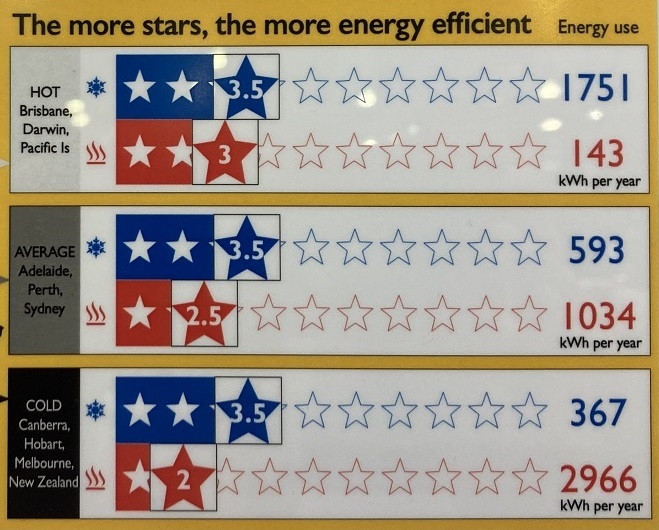

The more stars the air conditioner has, the better. The unit in the example above is clearly less efficient at heating than cooling and I wouldn’t recommend it for Canberra. The fact it drops from 3 stars for warming in the hot climate zone to only 2 in the cold climate zone suggests it doesn’t handle very cold temperatures well.
Determining Aircon Operating Costs
Here’s the government’s 4-step guide to using the energy efficiency information:
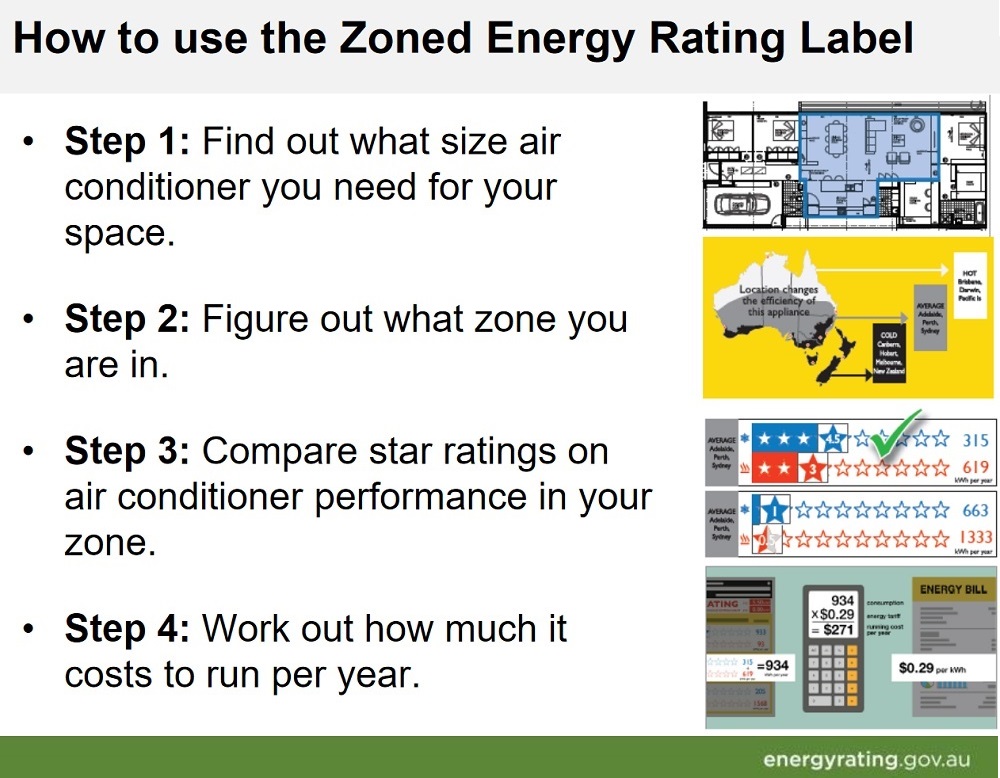

It seems pretty easy when they put it like that.
To work out how much money it will cost you to run the air conditioner over a year — step 4 above — you add the energy use figures for cooling and heating to get the number of kilowatt-hours it is expected to use in a year and multiply the amount by how much your electricity costs. If you live in Brisbane, you’d look at the figures for the hot climate zone and add them together like this:


If you only use grid electricity with a flat tariff then it’s easy to multiply the total annual kilowatt-hours by what you pay for electricity to get the total operating cost. If you pay 20 cents per kilowatt-hour for electricity, then with the above example a typical household would pay $379 a year to run the air conditioner.
If you have solar panels — something I definitely recommend having — it becomes a little trickier. With the following assumptions:
- 20 cents per kilowatt-hour for grid electricity.
- 10 cents solar feed-in tariff.
- Half the electricity consumed is solar electricity.
Then the average cost would be 15 cents per kilowatt-hour and the air conditioner would cost $284 a year to run. It’s important to include the feed-in tariff you miss out on as a cost because otherwise it would go towards reducing your electricity bill.
If you have a time-of-use tariff, things become more complex and you may have to make a rough guess as to how much the average kilowatt-hour used by your air conditioner will cost you.
Note the figures you’ll get are for typical use in the reference location. If you know your air conditioner use is likely to be unusual, for example if you hate the cold but love the heat, or leave it running all year, or you’ve installed it in a tent — then you’ll have to adjust your estimate as best you can.
Up To 10 Stars
The maximum number of energy stars an air conditioner can have for cooling or heating is 10. The most received by any air conditioner tested so far is 8 for cooling. This leaves two unused stars for possible future improvements in efficiency.
The more stars, the more heat energy will be pumped out of your home when cooling — or into your home when heating — per kilowatt-hour of electricity, as shown by the following examples:
- 1 Star: The air conditioner pumps 2.5 to 3 kilowatt-hours of heat per kilowatt-hour of electricity consumed.
- 2 Stars: The air conditioner pumps 3 to 4.5 kilowatt-hours of heat per kilowatt-hour of electricity consumed.
- 3 Stars: The air conditioner pumps 4.5 to 5 kilowatt-hours of heat per kilowatt-hour of electricity consumed.
Going by this progression, a hypothetical, future, air conditioner with a 10 star rating could pump an impressive 7 to 7.5 kilowatt-hours of heat per kilowatt-hour of electricity.
Air Conditioner Noise
The final part of the new label gives the noise level of the air conditioner in decibels for both the inside wall unit and the outside compressor unit:


While it’s useful to give the decibel levels, this part of the label needs to be improved because very few people have any idea what decibels are. The government guide to the new labels gives the following examples:
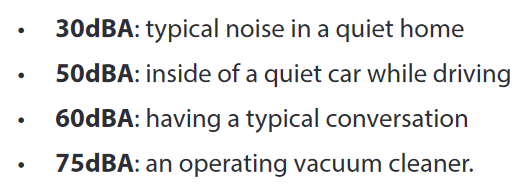

It would be very easy to add these descriptions, or something similar to the labels. Most people don’t have a clue what “64 decibels” mean, but if they instead read…
- 64 Decibels — Noise volume of a typical conversation.
…then they’ll realize this particular air conditioner isn’t very quiet.
Advertising Stars
While each newly tested air conditioner must come with a full label, smaller and simpler versions can be used online or in printed advertising. They look like this:
![]()
![]()
An Appreciated Improvement
Air conditioners are responsible for increasing the cost of electricity due to the strain they put on the grid. Rooftop solar power has helped reduce this strain, but for some reason, this benefit is never acknowledged by our current federal government.
Without the improvement in efficiency driven by regulation over the past 18 years, air conditioner use would have pushed electricity prices even higher. Anything that helps people select more energy-efficient appliances, such as the new air conditioner labels, is appreciated.
If you have an old inefficient air conditioner — or even a new inefficient one — replacing it with a unit with just a couple more energy stars can potentially save hundreds of dollars a year. While it may seem wasteful to replace an air conditioner still in working order, you may find you are financially better off with something more energy-efficient. It can be good for your bank balance and good for the planet.
On the other hand, what could be even better for the planet and save you even more money is keeping your old air conditioner for now and putting the money towards a large new solar system for your roof. You can use our Solar & Battery Calculator to estimate how much you can save. While saving energy by getting a more efficient air conditioner is good, making energy can be even better. But, provided your budget stretches far enough, I suggest both.




Footnotes
Original Source: https://www.solarquotes.com.au/blog/air-conditioner-energy-labels/

